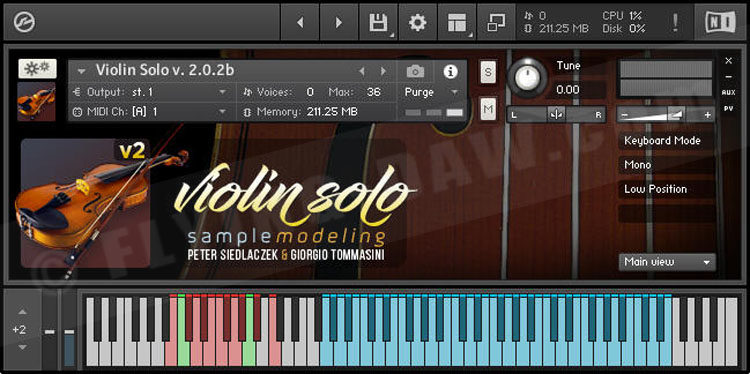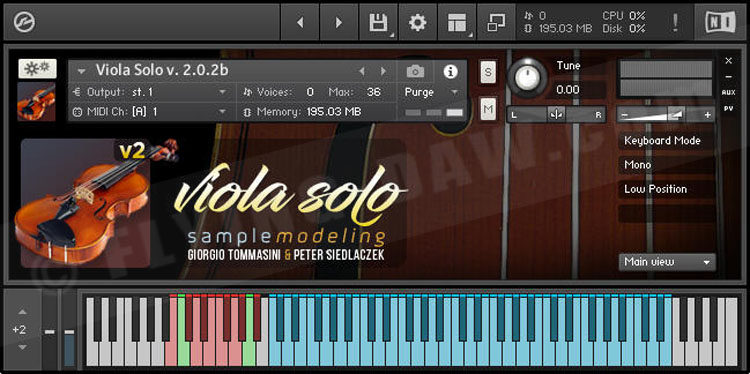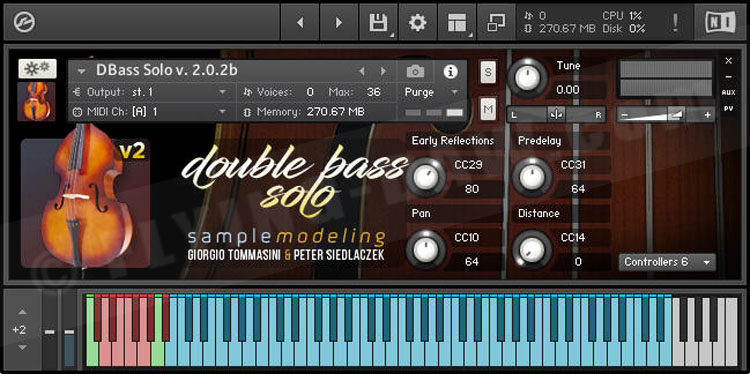Product Introduction 产品介绍
Another string package? Why? There are already so many, either conventional libraries or based on physical modeling!
Do we still need another one? The answer is YES. But not just another one.
Something completely different. We need virtual instruments overcoming the limits of the current approaches.
With a realistic timbre, sample-based, but allowing any kind of soundshaping and user-molded articulation, according to Samplemodeling philosophy.
Equally suitable for composition and realtime playing. Including all solo & ensemble string instruments.
Compact and flexible. Not an easy task, which required four years of intensive research & development.
另一个弦乐音色包? 为什么? 已经有这么多,要么是传统的采样音色库,要么是基于物理建模的!
我们还需要另一个吗? 答案是肯定的。 但不仅仅是另一个。
我们要完全不同的东西。 我们需要克服当前技术限制的软音源。
根据 Samplemodeling 的理念,具有逼真的音色,基于采样,但可以让用户对声音进行塑造以得到更好的表现力。
同样适用于作曲和实时演奏。 包括所有独奏、室内乐演奏和合奏弦音色。
紧凑而灵活。 这不是一件容易的事,需要六年的专心研发。
Now the brand new Samplemodeling Solo & Ensemble Strings are finally available,
in a single package, at a very affordable price.
现在,全新的 Samplemodeling Solo & Ensemble Strings 终于上市了,
整合到一个音色库中以实惠的价格购买。
Instrument Technology
Powered by Native Instruments KontaktSolo & Ensemble Strings further expand Samplemodeling™ technologies.
Multi-microphone anechoic recording allows to capture the original timbre of the instruments, along with their radiation pattern.
Our proprietary "Harmonic Alignment" yields continuous transitions across virtually infinite dynamics.
Specially devised "early reflections" impulse responses add a virtual space to the anechoic sound, greatly contributing to realism.
New, patent pending technology allows to vary the perceived size of the ensemble in a continuous manner.
The programming moves further away from conventional libraries, by exploiting physically-oriented modulation of the recorded sound.
The result are playable, very expressive virtual instruments retaining the rich, full sound of real strings.
音色技术
由 Native Instruments Kontakt 提供引擎,Chamber & Ensemble Strings 进一步扩展了 Samplemodeling™ 技术。
多麦克风消声录音允许捕捉乐器的原始音色以及它们的声学特性。
我们专有的“谐波对齐”技术跨越几乎无限动态的连续转变。
特别设计的“早期反射”脉冲响应为消声声音增加了虚拟空间,极大地提高了真实感。
新的、正在申请专利的技术允许以连续的方式改变整体的感知大小。
通过对录制的声音进行面向物理的调制,该程序与传统的采样音色库完全不同。
结果是可演奏、极具表现力的音色,保留了真实弦乐的丰富、饱满的声音。
The package includes four solo instruments, namely Violin, Viola, Cello and Double Bass, and five ensembles, Violins I & II, Violas, Cellos and Double Basses.
The base material of the instruments consists of 5 GB of samples, chromatically performed by professional string players over a very wide dynamic range.
All samples are unlooped, and have a minimum duration of about 10 sec.
The Strings engine is structured according to an adaptive model, based on the performance "fingerprints" of the real instruments.
The purpose of the model is to minimize the differences between the real phrases and those played by the virtual instruments.
该音色库包括四个独奏音色,即小提琴、中提琴、大提琴和低音提琴、五重奏室内乐和五个更大的合奏、小提琴 I 和 II、中提琴、大提琴和低音提琴。
乐器的基础音色由 5 GB 的采样组成,由专业弦乐演奏者在非常宽的动态范围内进行半音演奏。
所有采样均未循环,且最短持续时间约为 10 秒。
弦乐引擎是根据自适应模型构建的,基于真实乐器的演奏“指法”。
该模型的目的是尽量减少真实乐句与虚拟乐器演奏的乐句之间的差异。
Violin Solo 小提琴独奏界面:
Viola Solo 中提琴独奏界面:
Cello Solo 大提琴独奏界面:
Double Bass Solo 低音提琴独奏界面:
Proprietary instrument body IRs, innovative techniques for sample modulation and advanced artificial intelligence MIDI processing are used for real time construction of
all articulations and morphing across dynamics, vibrato, legato, portamento, cross-string, portato, trills, tremolo, staccato, pizzicato, col legno, harmonics and so forth.
专有的乐器主体 IR、采样调制的创新技术和先进的人工智能 MIDI 处理用于实时构建所有技巧和变化,
包括动态、颤音、连奏、滑音、交叉弦、滑音、颤音、震音、断奏、拨弦、泛音等。
Pseudo-random detuning and pitch & dynamics modulation, based on real performance-derived trends,
is another outstanding feature of Samplemodeling Solo & Ensemble Strings,
adding further realism.
基于真实演奏产生的伪随机失谐和音高和动态调制是 Samplemodeling Solo & Ensemble Strings 的另一个突出特点,
进一步增加了真实感。
Why anechoic?
The purpose of anechoic recording was threefold:
1.avoid “contamination” of the pure strings sounds with the uncontrolled resonances of a particular ambience,
2.allow artifact-free “harmonic alignment” processing
3.provide clean articulations and phrases as a database to build the “adaptive model”.
为什么要用消声?
消声录音的目的有三个:
1.避免特定环境的不受控制的共振“污染”纯弦乐的声音,
2.允许无相位失真的“谐波对齐”处理,
3.提供清晰的发音和短语作为数据库来构建“自适应建模”
Which are the main features of Solo & Ensemble Strings?
The Strings include several exciting features:
Solo & Ensemble Strings 的主要特点是什么?
弦乐包括几个令人兴奋的功能:
Velocity mapping
User-drawn rescaling of the note-on velocity allows greater flexibility and better control of the articulations.
This is particularly suitable for breath or wind controllers, or other physical input devices.
力度映射
用户绘制的音符力度调整允许更大的灵活性和更好的技巧控制。
这特别适用于呼吸或吹管控制器,或其它硬件输入设备。
Early Reflections algorithm
The early reflections (ER) are those components of the emitted sound reaching the listener shortly after being reflected from the closest walls, floor and ceiling.
They convey information about the spatial localizaton of the instrument, and greatly contribute to realism.
In the Strings, a sophisticated algorithm extracts the directional information of multi-microphone anechoic recordings to recover the overall timbre of the instruments
along with their radiation pattern, assembling this information into a suitable ER impulse response, which adds a virtual space to the anechoic sound.
早期反射算法
早期反射 (ER) 是发出的声音在从最近的墙壁、地板和天花板反射后不久到达听众的那些成分。
它们传达有关乐器空间定位的信息,并极大地增强了真实感。
在弦乐中,一种复杂的算法提取多麦克风消声录音的方向信息,以重现乐器的整体音色及其反射结果,
将这些信息组合成合适的 ER 脉冲响应,从而为消声声音增加虚拟空间。
Built-in Reverb
Each instrument, solo & ensemble, is equipped with a high quality convolution reverb, with several selectable IRs,
ranging from a small chamber orchestra space to a large auditorium.
The dry/wet ratio, IR length and predelay are under user's control. This internal reverb permits to get a full realistic sound straight out-of-the-box.
When set to zero, the internal convolution reverb is switched off, allowing the use of your preferred ambience setup.
内置混响
每个乐器,独奏和合奏,都配备了高质量的卷积混响,
具有多个可选的 IR,从小型室内乐团空间到大型礼堂。
干湿比、IR 长度和预延迟由用户控制。这种内部混响可以让你即刻获得完整逼真的声音。
当设置为零时,内部卷积混响被关闭,你可以使用干声或者自己另外使用其它的混响。
Microtuning
Another important feature is microtuning, coping with the requirements of musicians using non-tempered scales, as in Middle Eastern and Asian music.
Our approach to microtuning yields maximal flexibility, allowing user-defined scales,
where the extent of detuning (range +60/-60 cents) can be precisely set for each note by means of a series of bars.
The scale can be saved as a preset and recalled by dedicated keyswitches.
微调律制
另一个重要功能是微调,可以满足音乐家使用非调律音阶的要求,如中东和亚洲音乐。
我们的微调方法产生了最大的灵活性,允许用户定义音阶,
其中可以通过一系列条形参数精确设置每个音符的失谐程度(范围 +60/-60 音分)。
刻度可以保存为预设并通过专用按键开关调用。
Unison Ensemble Multi
Special consideration has been given to creation of realistic unison ensembles.
An advanced "Ensemble Maker" has been developed, affecting timing, static and dynamic pitch evolution, phase, response to dynamics, pitchbend, velocity, portamento time,
in such a way that even if driven from a single MIDI source, each instrument will sound slightly different, as if played by a different musician.
The ensemble use specially devised IR, markedly reducing the phasing which may occur when several instruments are driven from the same MIDI track (i.e. in unison).
A completely new, patent pending, technique has been developed,
allowing to vary the perceived ensemble size in a continuous manner, ranging from a small chamber orchestra to a large symphonic ensemble.
Ensemble vibrato varies from random to slightly synchronized, under CC control, to impart a more expressive character to intense climaxes.
Five ready-to-use Ensembles, including First and Second Violins, Violas, Cellos, Double Basses and an appropriate convolution reverb,
suitable for unison playing straight out of the box, are included in the package.
The reverb can of course be bypassed in each ensemble if one wants to use his own ambience.
同音合奏多重音色组
为了创建逼真的统一合奏,特意开发了一种先进的“Ensemble Maker”,
它影响时间、静态和动态音高演变、相位、对动态的响应、弯音、力度、滑音时间,
即使从同一条 MIDI 轨播放,每个乐器也会发出声音略有不同,好像是由不同的音乐家演奏的。
合奏使用专门设计的 IR,显著减少了从同一 MIDI 轨道驱动多个音色时可能发生的相位问题。
一种全新的、正在申请专利的技术已经开发出来,
允许以连续的方式改变感知的合奏规模,范围从小型室内乐团到大型交响乐团。
合奏颤音从随机到轻微同步变化,在 CC 控制下,为激烈的高潮赋予更具表现力的特征。
音色库中包含五种合奏,包括第一和第二小提琴、中提琴、大提琴、低音提琴,
还有适当的卷积混响,适用于同音演奏。
如果一个人想使用自己的空间,当然可以在每个合奏中绕过混响。
Additional techniques and articulations
Several playing techniques which can be applied to string instruments (e.g. pizzicato)
and some articulations (e.g detaché) are easily recalled by using keyswitches (KS).
These KS are placed immediately below the playing range of each instruments.
By pressing a KS you can activate microtuning, pizzicato, col legno, harmonics, solo or poly (arpeggio) mode, detaché/bowchange, portato & tremolo,
allow open strings and selecting low, middle and high playing position.
All the KS are working in real time, either in momentary or latch mode.
其他技术和技巧
可以使用键位开关 (KS) 轻松调用和切换演奏技巧(例如拨奏)。
这些 KS 键位开关直接放置在每个乐器的演奏范围低音区。
通过按 KS 键位,你可以激活微调、拨奏、泛音、独奏或复音(琶音)模式、分离/换弓、滑奏和颤音,
可以选择低音、中音和高音演奏位置。
所有 KS 都是实时生效的,无论是实时模式还是保持模式。
Expression Mapping
User-drawn rescaling of the expression CC allows better control of the dynamics.
This is particularly suitable for breath or wind controllers, or other physical input devices.
表达式映射
用户绘制的表达式 CC 控制器的重新定义可以更好地控制动态。
这特别适用于呼吸或吹管控制器,或其他物理输入设备。
Pitchbend Mapping
User-drawn rescaling of the Pitchbend allows to tailor the response to different input devices. Some devices,
for example require that subtle PB oscillations are strongly amplified, while large ones remain within the PB range.
The latter has been extendend to +/- 3 semitones for particular applications.
弯音映射
用户绘制的弯音轮重新缩放允许定制对不同输入设备的响应。
例如,某些设备需要更大的弯音范围。
你可以将弯音范围应用到 +/- 3 半音音程的弯音设备上。
Virtual Soundstage
This feature allows precise positioning of the instruments in a virtual space located before the listener,
using early reflections, pre-delay, convoluted panning, stereo field width, and perceived distance algorithms.
You can move your instruments back and forth, from side to side, or with a combination of the two, even in realtime, mimicking the natural movements of the player.
You can modify the ratio direct/reflected sound, and even "displace" the back wall, for a variable depth effect.
虚拟声场
此功能允许使用早期反射、预延迟、声像、立体声场宽度和感知距离算法将乐器精确定位在位于听众面前的虚拟空间中。
你可以来回移动乐器,左右移动,或者将两者结合使用,甚至可以实时移动,模仿演奏者的自然动作。
你也可以修改直接/反射声音的比率,甚至“置换”后墙,以获得可变深度效果。
Real time Timbral Shaping
This revolutionary new feature adds a virtually endless timbral variety to sample-based instruments,
by acting on the amplitude of individual harmonics, or groups of harmonics, even in real time.
This is not a graphic equalizer; the controlling bars are not assigned to fixed frequencies, but to the first 10 harmonics of the played note.
As a consequence, the affected frequencies vary with the pitch of the note.
So, rising, for example, bar #1 will boost the fundamental frequency (first harmonic) of each note played, yielding a "rounder" sound.
Rising bars #3, #4, #5 will increase the intensity of the corresponding harmonics for a more "nasal" sound, etc.
"Sul tasto" and "sul ponticello" can be mimicked by boosting, for example, the first harmonic while decreasing the level of some upper harmonics, and the reverse.
Timbral shaping can also be controlled in realtime by suitable CCs.
实时音色整形
这一开创性的新功能通过作用于单个泛音或泛音组的幅度,
甚至实时为基于采样的乐器带来了几乎无穷无尽的音色变化。
这不是图形均衡器;控制条不分配给固定频率,而是分配给演奏音符的前 10 个泛音。
因此,受影响的频率会随着音符的音高而变化。
例如,提升每个音符的基频(第一谐波),从而产生“更圆润”的声音。
而 #3、#4、#5 将增加相应谐波的强度。
“Sul tasto”和“sul ponticello”可以通过增强来模仿,例如,第一谐波,而降低一些高次谐波的电平,反之亦然。
音色塑形也可以由合适的 CC 实时控制。
Articulations
Despite their structural complexity, these instruments are very intuitive and easy to play.
As all Samplemodeling instruments, the Strings do not use pre-recorded articulations,
and shaping the sound is the task of the player, carried out by proper use of a few midi controllers.
However, extensive use of advanced Artificial Intelligence (AI) techniques greatly facilitates this task.
Our revolutionary “Adaptive Model” approach acts by minimizing the differences from the real instrument, whatever articulation or phrase you play.
You can therefore concentrate on creating music, rather than mastering complex sample bank management.
Nevertheless, thorough knowledge of the controllers and the keyswitches, and some practice, are certainly needed to get most realistic effects.
演奏技巧
尽管结构复杂,但这些乐器非常直观且易于演奏。
与所有 Samplemodeling 音色一样,弦乐不使用预先录制的技巧,
塑造声音是演奏者的任务,通过正确使用一些 MIDI 控制器来完成。
然而,高级人工智能 (AI) 技术的广泛使用极大地促进了这项任务。
我们开创性的“自适应模型”方法通过最小化与真实乐器的差异来发挥作用,无论你演奏的是什么发音或乐句。
因此,您可以专注于创作音乐,而不是掌握复杂的采样音色库管理。
然而,要想获得真实的效果,肯定需要对控制器和按键开关有透彻的了解,并进行一些练习。
Seamless continuous crescendo-decrescendo across several dynamics is simply obtained by acting on the expression controller.
The attacks are controlled by the interplay between note-on velocity and the expression CC.
Legato/portamento is activated by overlapping notes, and the duration of the articulation is linked to note-on velocity, or if needed, can be assigned to an independent CC.
Trills are easily obtained by retriggering. Pure staccato can be obtained by very short strokes with high note-on velocity.
And.. simply play at very low dynamics and lowest velocity, and you will get a very realistic "subpianissimo" sound.
跨多个动态的无缝连续渐强渐弱可以通过作用于表达式控制器来简单地获得。
起音时间是由音符上的力度和表情 CC 之间的相互作用控制的。
Legato/portamento 由重叠的音符激活,发音的持续时间与音符上的力度相关联,或者如果需要,可以分配给独立的 CC。
通过重新触发很容易获得颤音。纯粹的断奏可以通过非常短的高音力度获得。
而且..只需以非常低的动态和最低的力度播放,您将获得非常逼真的“subpianissimo”声音。
Mode & Articulation Display
The instruments displays the selected input device (keyboard, breath controller, wind controller),
identifies mode (solo, poly, detaché), technique (tremolo, pizzicato, col legno, harmonics),
articulation (downbow, upbow, bichord, accent, staccato, legato, cross-string, portamento, trill, run)
and playing position (open strings, low, high, highest), and displays this info in real time on the main GUI.
模式和技巧显示
乐器显示选定的输入设备(键盘、呼吸控制器、吹管控制器)、
识别模式(独奏、多音、分离)、技巧(颤音、拨弦、谐波)、
技法(下弓、上弓、和弦、重音、断奏、连奏,换弦,滑音,颤音,Runs)
和演奏把位(空弦,低,高,最高),并在主界面上实时显示此信息。














